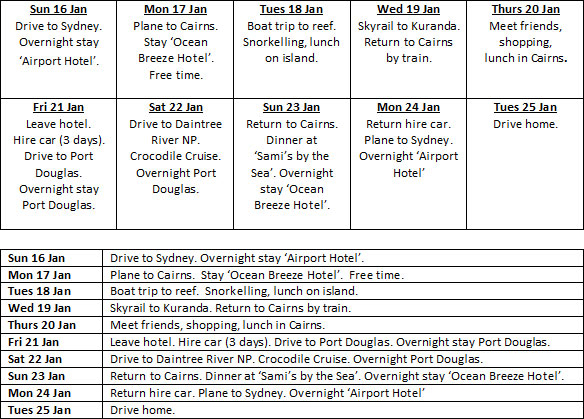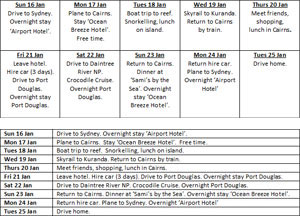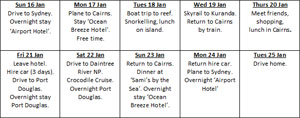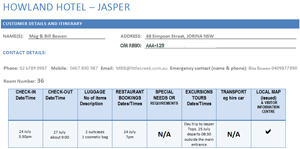- Able to understand how to:
- - prepare for and conduct tourism activities and itineraries
- - count groups and multiple luggage items, and reconcile against checklists and reservation data
-
Prepare for and Conduct Tourism Activities
Click on the Play button to start the introduction video.
-
Show Me!
Show Me!
Tourism Activity DocumentsClick on the Play button to start the video.
Documents associated with the organisation of tourism activities need to be simple and easy to follow.
We need to remember the three C's:
- clear.
- concise.
- correct.
Tourism documents are usually created in a spreadsheet or table, and require an easy, quick method to record details. Documents may include:
- itineraries
- checklists
- reservation data
It is also important to understand how to reconcile information, that is, compare initial information with later information.
Reconciliation:
- means that figures need to balance, or be equal, for example:
- the number of tourists who depart for an activity compared with number who return.
- is vital for the security of tourists' property, the safety of clients and the reputation of the tourism organisation.
Same but different
In the Tourism and Hospitality Industry it is important to realise that different workplaces may do or say things differently; this may occur in the terms used or the layout of forms.
client customer, guest, tourist, visitor, participant tour guide tour leader, tour escort tour coach tour bus places to eat restaurants, cafes, bistros, kiosks, brasseries, pizzerias, steakhouses, taverns, diners, eateries, inns Visitor Information Centres Tourist Information Centres itinerary travel plan, tour plan Checklists, reservation data forms and itineraries can also be presented in different ways.
Itineraries may be presented, for example:
- in calendar format.
- In chronological order.
Checklists
Tourism activities, such as day and half day coach tours, have a tour guide.
The tour guide:
- is the local expert and is responsible for relating information about local sights and attractions.
- has a Duty of Care to everyone in the group.
- needs to be aware of the employer's policies and procedures.
- needs to be aware of risk minimisation and safety of groups.
- must count the number of passengers at the start and end of the tour; this is called a Head Count.
- record the Head Count on a checklist.
Reservation data forms
Reservation data is the information required from a guest at check-in. Reservation data forms have the following information:
- hotel name and location.
- customer details and itinerary.
- name of customer.
- address of customer.
- contact details - phone, mobile, email address.
- emergency contact name and phone number.
- room number.
- check-in date and time.
- check-out date and time.
- luggage - number of items and description.
- restaurant bookings - dates and times.
- special needs or requirements.
- excursions/tours - dates and times.
- transport, eg hire car.
When filling out reservation data check the following:
- name of customer, and spelling of name.
- phone numbers - repeat number back to the customer.
- time - show am or pm, or use 24 hour time.
- use N/A when an item does not apply to a customer.
- use a tick to show that something has been done.
-
Say It
There are 2 parts in this section.
1. The GlossaryThe glossary lists the more difficult words related to the topic in alphabetical order. The glossary also gives the meaning for each word.
2. Look, Cover, Write, Check!This activity gives you practice at remembering and writing the words from the glossary.
The Glossary
-
Do It
Documents associated with the organisation of tourism activities need to be simple and easy to follow. Once again, we need to remember the three C's: Clear, Concise, Correct.
Tourism documents are usually created in a spreadsheet or table, and require an easy, quick method to record details. Documents may include: itineraries, checklists and reservation data.
All of these would be created in table form and would require only a small amount of writing or typing to complete the details. It is also important for employees to understand how to reconcile information, that is, compare initial information with later information.
Reconciliation means that figures need to balance, or be equal. For example, luggage put on a plane compared with luggage taken off, and the number of tourists who depart for an activity compared with number who return.
Jump to ActivitiesDo It: Itinerary
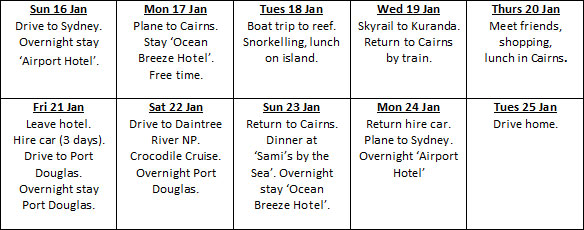
Do It: Customer Details And Itinerary
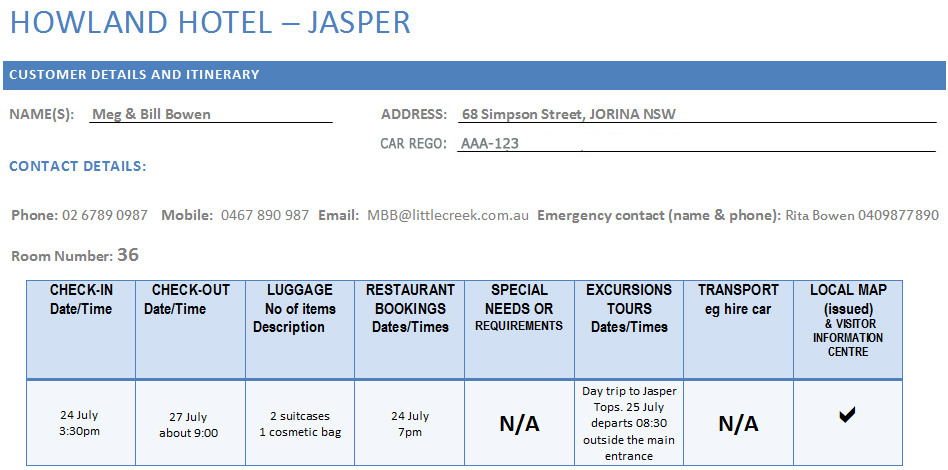
Do It: Tourism Activities

Check It
Check It QuizPrepare & Conduct Tourism ActivitiesClick on Prepare & Conduct Tourism Activities to begin.
Additional Resources:
Jasper Tops Walking Tours
- Introduction
- Show Me
- Say It
- Do It
- Check It
